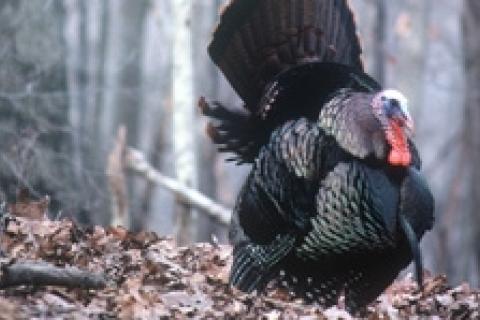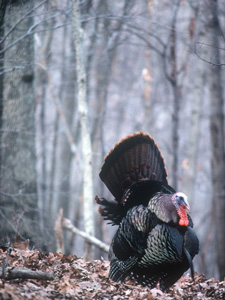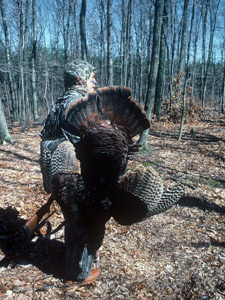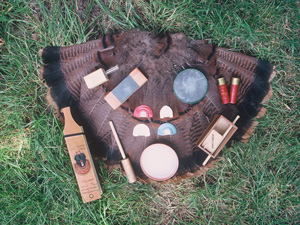
 It's a simple, stark truth. But it's one far too many of us who seek out long-bearded gobblers in spring ignore. The hunter who does the most preparation and puts the most work in before the opener is the one who will likely be toting out a hefty bird when turkey season arrives.
It's a simple, stark truth. But it's one far too many of us who seek out long-bearded gobblers in spring ignore. The hunter who does the most preparation and puts the most work in before the opener is the one who will likely be toting out a hefty bird when turkey season arrives.
Jim Clay, founder of Perfection Calls and a champion caller, tries to locate several dozen gobblers before the season opens, both in his home state of Virginia and neighboring West Virginia. Call it insurance. Call it diligent preparation. Call it what you will, but you'd be wise to emulate his hard work.
Not all of us, of course, have good enough areas that we can locate two dozen turkeys. Serious scouting, though, and locating and learning the habits of as many birds as you can ahead of time, is essential for a smooth and successful spring gobbler season. But getting ready for the upcoming season requires more than just scouting. Before even hitting the woods you should take a number of other preparatory steps. Here's a rundown on what you should do to be total ready for spring gobbler season.
Get in shape. For starters, you need to be physically up for the task. Hopefully you've already started this with an exercise program or maybe some shed antler hunting. If not, start with a few walks and stretching exercises. Then gradually build up to your maximum capability.
Turkey hunting can require lots of walking, sometimes in steep, rugged terrain. If birds aren't gobbling well, you may have to cover miles to find a cooperative tom. Be ready by getting in the best shape you can ahead of time. You'll also enjoy the sport more if you've not huffing and puffing up every hill.
Prepare your Gear. If you just stashed away your gun last spring, get it out and clean and oil it. Then take it to the range and test-fire it with several brands of ammo and different shot sizes to make sure you have the optimum load for your shotgun. Fire the gun at turkey head and neck targets to see how many pellets hit the vital area at different ranges.
Clean and check your decoys to see if any need replacing. Get camouflage out and make sure it's ready to go or replace it if it's faded or torn. Make sure that you have camo or drab colored clothing to cover every part of your body, including socks, gloves and face coverings. Think of the backgrounds you hunt against, too. You may need two different sets if you hunt early with no foliage out and late with lots of green vegetation growing.
Practice calling. Everyone needs a little brush-up before the season. Practice on your old standby calls and also try a few new ones either inside or away from the turkey woods where it won't matter if you make mistakes. It's better to get your sour notes out now, rather than during the season when a three-year-old bird with a 12-inch beard is hanging just out of range.
 |
| The author with a gobbler he harvested after lots of preason scouting. |
Scouting. Locating birds is the fundamental goal of scouting for spring turkey season. To do that, you need to cover ground. Use a combination of walking and driving in a car or ATV to cover lots of ground, working out isolated gravel and dirt roads and along ridge spines to call down into valleys, side spur ridges and bowls trying to locate birds. Try just listening first. This is the least conspicuous way to pinpoint toms. They don't even know you're there.
If you need to, then try locator calls such as owl, pileated woodpecker, hawk, gobbler and crow sounds to startle a response from nearby toms. Once you hear a bird, stop calling, unless you couldn't quite determine its location. As a final resort, use hen calls to incite gobbles from nearby toms. Once you pin down where they are, stop calling. You want to locate them, not educate them or potentially spook them before the season opens.
And don't give up on a spot just because you didn't hear anything one morning. Turkeys don't necessarily call every day. If a spot has potential, check it out several times in the weeks before the season opens.
Another good tactic is to climb to high observation areas such as ridge tops, fire towers or other areas where you can glass and search for birds in fields, natural meadows and open parts of woods. Bring a good pair of binoculars so you can search a wide area.
The best hunters do more than simply locate birds, though. I've been fortunate to hunt with some of the top turkey hunters in the country, including Rob Keck, Eddie Salter, Will Primos, Kelly Cooper and Jim Clay. Without exception, they all try to not just find gobblers ahead of the season but also pattern them.
After a bird gobbles, wait until daylight and see what it does. Which direction does it fly towards when it leaves the roost tree? Does it glide far down the hillside or just flutter down and land next to the tree it slept in? Does it tend to head for a field, an oak flat or a nearby water hole?
Also try to pinpoint where hens roost in relation to the gobblers. That's often the direction they'll head at first light. The more of these details you can pin down ahead of the season, the more likely you'll be able to figure out the tom's likely travel route and be waiting on it. Even the most expert callers will tell you that being in the right spot is often more important than how well you can yelp, purr, cluck and cutt.
Strutting areas are spots where birds display their fans and beards in front of hens year after year. Locate these in a sunny flat or bowl or on a soft knoll and plan on being there during prime breeding season. Also look out for gobbler droppings, scratched areas where the turkeys have fed, and dusting areas where the birds roll in the dirt and fan their wings to remove insects from their bodies.
 |
| Get all your gear ready and practice calling before the opener. |
Another thing about scouting is that it makes you familiar with ridges, hollows, areas of thick and thin cover, streams and other topographical features. Knowing those things will help you when you move to set up on a bird and enable you to choose the best calling location. Learn where thick areas are that a turkey wouldn't want to walk through or steep draws it might avoid. Look for terrain that's easy walking and where a bird will feel comfortable traveling through.
Also check out fields a short while after sunrise and even into mid and late morning. Turkeys often gravitate there for the bugs, tender green shoots and clover they find there. Knowing which part of the field they usually enter from can help you set up an ambush. And knowing which way they leave will allow you to set up at that exit location if you spot them already in the clearing during the season.
Certainly you can learn these things while turkey season is open. But the more of them you discover ahead of time, the more likely you can score before the turkeys become wary and hard to call or are harvested by other hunters.
Take either a topo or hand-drawn map of the hunting area with you as you try to locate birds and do your scouting. Mark spots where gobblers call from, where hens roost, water sources, fields you see turkeys in, dusting spots, feeding areas and strutting grounds. Gradually you'll begin to see patterns that will help you set up in the spot gobblers want to go to at a given time of day. And that, more than camouflage, calling or the gun you use is the key to a successful spring gobbler hunt.
Final Tip: Besides scouting your regular hunting areas, try to branch out and investigate at least one or two other new areas each spring. The more possible areas you have lined up and the more birds you locate, the better prepared you'll be for the season. That way, if a vehicle is parked at your chosen spot, you can simply drive on to the next prime area you know of. Competition is good in most sports, but not turkey hunting.
- 4986 views

